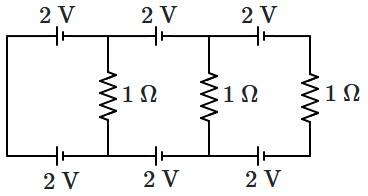In a large building, there are \(15\) bulbs of \(40~\text{W}\), \(5\) bulbs of \(100~\text{W}\), \(5\) fans of \(80~\text{W}\) and \(1\) heater of \(1~\text{kW}\). The voltage of the electric mains is \(220~\text{V}\). The minimum capacity of the main fuse of the building will be:
1. \(10~\text{A}\)
2. \(12~\text{A}\)
3. \(14~\text{A}\)
4. \(8~\text{A}\)
When \(5~\text{V}\) potential difference is applied across a wire of length \(0.1~\text{m}\), the drift speed of electrons is \(2.5\times 10^{-4}~\text{ms}^{-1}\). If the electron density in the wire is \(8\times 10^{28}~\text{m}^{-3}\), the resistivity of the material is close to:
1. \(1.6 \times 10^{-8}~\Omega\text-\text{m}\)
2. \(1.6 \times 10^{-7}~\Omega\text-\text{m}\)
3. \(1.6 \times 10^{-6}~\Omega\text-\text{m}\)
4. \(1.6 \times 10^{-5}~\Omega\text-\text{m}\)
In the circuit shown, the current in the \(1~\Omega\) resistor is:
| 1. | \(1.3~\text{A},\) from \(P\) to \(Q\) |
| 2. | \(0~\text{A}\) |
| 3. | \(0.13~\text{A}\), from \(Q\) to \(P\) |
| 4. | \(0.13~\text{A}\), from \(P\) to \(Q\) |

1. \(11.9 ~\text{V}\)
2. \(13.1~\text{V}\)
3. \(12.5~\text{V}\)
4. \(24.5~\text{V}\)
| 1. |  |
3. |  |
| 2. |  |
4. |  |

1. \(6~\text{V}\)
2. \(3~\text{V}\)
3. \(5~\text{V}\)
4. \(4~\text{V}\)
In the given circuit diagram when the current reaches steady state in the circuit, the charge on the capacitor of capacitance \(C\) will be:
1. \(CE \)
2. \({CE} \frac{r_1}{\left(r_2+r\right)} \)
3. \({CE} \frac{r_2}{\left(r+r_2\right)} \)
4. \( C E \frac{r_1}{\left(r_1+r\right)}\)
In the circuit shown, three \(1~\Omega\) resistors are connected vertically between the upper and lower conductors. Each section of both the upper and lower conductors contains an ideal \(2~\text{V}\) source, all orientated in the same direction. The left ends of the two conductors are directly connected.

What is the current through each of the \(1~\Omega\) resistor?
| 1. | \(1~\text{A}\) | 2. | \(0.25~\text{A}\) |
| 3. | \(0.5~\text{A}\) | 4. | \(0~\text{A}\) |
Which of the following statements is false?
| 1. | Wheatstone bridge is the most sensitive when all the four resistances are of the same order of magnitude |
| 2. | In a balanced Wheatstone bridge if the cell and the galvanometer are exchanged, the null point is disturbed |
| 3. | A rheostat can be used as a potential divider |
| 4. | Kirchhoff’s second law represents energy conservation |

1. \(\frac{l_1}{l_1+l_2}\)
2. \(\frac{l_2}{l_2-l_1}\)
3. \(\frac{l_1}{l_1-l_2}\)
4. \(\frac{l_1}{l_2-l_1}\)








